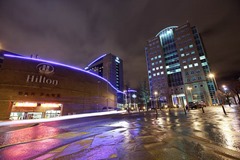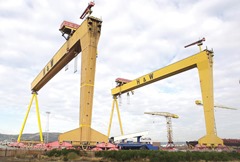An economy in numbers
 Five years after the credit crunch, Northern Ireland remains a complex economy with an openness to outside markets but also continued high dependence on the public sector. agendaNi sums up the region’s key economic statistics.
Five years after the credit crunch, Northern Ireland remains a complex economy with an openness to outside markets but also continued high dependence on the public sector. agendaNi sums up the region’s key economic statistics.
Labour market breakdown
796,000 In Employment
591,000 Full-time
197,000 Part-time
671,000 Employees
108,000 Self-employed
66.3% Employment rate (percentage of 16-64 year olds)
64,000 Unemployed
62,400 Claiming jobseeker’s allowance
34,600 Long-term unemployed (one year or more)
7.5% Unemployment rate
567,000 Economically Inactive
164,400 Students
141,800 Ill or disabled
136,100 Looking after families or the home
73,700 In early retirement
45,400 Inactive for other reasons
28.2% Economic inactivity rate (percentage of 16-64 year olds)
Unemployment rate is a percentage of the economically active population
Economic inactivity represents 16-64 year olds outside the workforce.
Great Britain: £7.64 billion
Republic of Ireland: £1.27 billion
Rest of EU: £1.39 billion
North America: £986 million
Middle East & Asia: £637 million
Rest of world: £957 million
Figures for 2011-2012
Not the worst off but no room for complacency
Despite its image as a deprived region, Northern Ireland is not the poorest region in the UK. The index for gross value added per capita compares each region against a national average of 100.
In 2011, Northern Ireland’s ranking was the third lowest (79.2 per cent of the national average) and ahead of North East England (75.9) and Wales (75.2). This position has been maintained by higher public spending and has stayed at that ranking in every year between 1997.
However, this also disguises wide differences within the region. Impressively, Belfast city had the fourth highest GVA per capita (159.0) for a local area, just below central London and Edinburgh. The east of the province (71.0) and outer Belfast area (64.5) had more in common with Yorkshire.
The ‘west and south’ zone, taking in Fermanagh, Tyrone and Armagh, stood at 63 per cent and was closely followed by the ‘north’ area (61.2 per cent) which covers Derry, Strabane and Coleraine. This is the poorest part of Northern Ireland and ranks ninth from the bottom in the UK table. More deprived districts include Blackpool (60.9), the Gwent valleys in South Wales (55.7) and the Wirral (53.5) on Merseyside.
To take a wider perspective, Northern Ireland’s regional gross domestic product was 86 per cent of the EU average in 2010. The north and west of the Republic had a similar performance (85) but the south and east were much more prosperous on 145 per cent.
Rebalancing the economy stalls
While Executive economic policy calls for the rebalancing of the public and private sectors, the two workforces remain at the same proportions they held in early 2007: 69 per cent private and 31 per cent public. Private sector employment peaked in Q2 2008 before falling continuously until Q3 2009. A slight recovery in jobs numbers took place in 2010 but has largely been cancelled out by further reductions since then.
The public sector was steadily decreasing in size, in line with the Executive’s plans, until Q2 2008. In the following year, 9,300 people moved into public sector jobs, partly as a response to private sector lay-offs. Public sector employment started to decrease sharply from Q3 2009 (well before the Coalition Government took office) and job cuts continued at that pace until Q4 2011 before more stability returned.
Perspective for cuts
Politicians and unions have regularly protested against Tory cuts since 2010 but reductions in everyday spending are small compared to the rest of the UK. The Coalition Government’s 2010 Spending Review set out the planned level of cuts up to 2015.
The resource part of Northern Ireland’s block grant will drop by 6.9 per cent over that period. This is similar to Scotland (6.8 per cent) and Wales (7.5 per cent) but public services in England have taken on a much higher burden.
Spending on communities (mainly housing) will drop by 51 per cent, accompanied by substantial cuts across environmental programmes and local government. However, English health spending should go up by 1.3 per cent and UK international development funds by 37 per cent.
Northern Ireland, though, is experiencing a major drop in capital spending which was due to fall by 37 per cent but the Economic Pact now allows for more funds. This is also comparable to Scotland and Wales (38 and
41 per cent respectively) but not as large as capital cuts for English education (60 per cent) and house-building (74 per cent). Deeper reductions in the block grant are expected in the next Spending Review in 2015.






